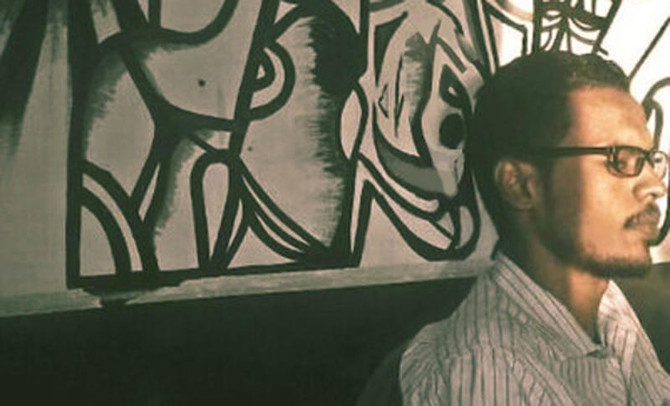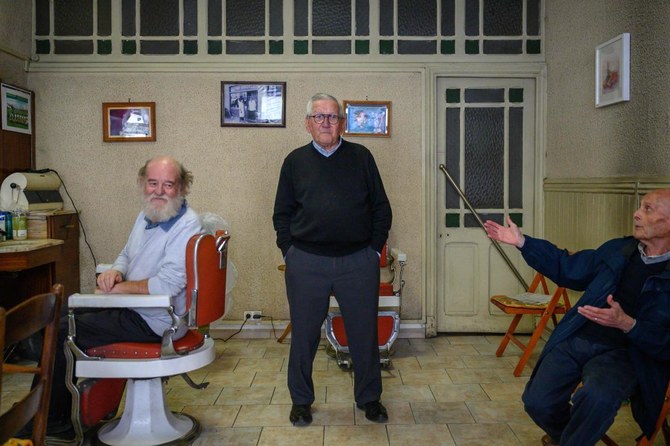Personally, I have been blessed to meet highly talented Sudanese men and women. Mass-media seems to always portray Sudan as poor, violent and corrupt. These issues might be there, but there is also light! It is a rich culture to be discovered with their people’s loyalty toward their heritage. There are talents in and out of Sudan always representing the true culture. One of these talents is our guest today, Sufyan Ali who is a Sudanese music producer that has impacted the world with his authentic beats. It will not take long for you to fall in love with the sound Sufyan gives you, it will also not take long for you to start picturing Sudan with its beauty, art and strength.
Arab News sat down with Sufyan and had the below discussion:
Arab News: Was there any one moment that actually inspired you to start producing?
Sufyan Ali: There wasn’t a specific moment as far as I can remember, but I always had the curiosity for making music in general. I started making beats for the first time maybe five years ago just so I could have something to rap on; but gradually I found myself writing less, and producing more. And eventually I was 100 percent producing.
AN: You’re from Sudan, but you have lived in Kuwait. Does that factor have an impact on your music?
SA: Yes, to some extent. Growing up in Kuwait, I had a lot of friends with completely different taste in music, we would spend a lot of time exchanging cassettes, and doing mix CDs of songs we recorded off the radio, which lead us to absorb a huge variety of genres, and I think it helped in shaping my outlook on music in general. And of course, after moving to Sudan, I became more exposed to Sudanese music, which is a huge part of my sound.
AN: You’re also a dentist! Do you ever work while your tunes are playing in the background?
SA: I haven’t done that before, but I usually cannot stay focused on important tasks while listening to music without being distracted. Maybe in the waiting room, for patients, some elevator style music.
AN: I personally enjoy the samples you use, the tunes you create. Tell our readers, how would you describe your sound?
SA: I would describe my sound as Sudanese inspired beats, I try to keep a flexible approach to making beats in general, that’s why my own definition of a genre is pretty loose. I’m either making electronic music with Sudanese/East-African elements, or I’m sampling old Sudanese records into hip-hop beats, the latter being “Pseudarhythm.”
AN: Your beat-tape “Pseudarhythm” samples Sudanese music in a hip-hop style. How has the feedback been on that tape?
SA: It’s been great. The feedback was awesome, I’ve been receiving a lot of random messages from people of different backgrounds from around the world interested in knowing more about old Sudanese records. I’m always happy to help.
AN: What are your thoughts on the Arab hip-hop movement? Who do you listen to?
SA: The scene has definitely been growing in the last 6-7 years in terms of both quality and quantity of music. I get introduced to new producers and MCs every now and then, and it’s always refreshing. There are a lot of strong movements and hip-hop communities on social media and such.
Now, the scene itself is not weak, but it’s definitely under-appreciated, and there are a lot of factors in play that are keeping it underground. and of course, the social stigma attached to hip-hop still being “foreign” in the Middle East, the average listener doesn’t have much input on Arabic hip-hop besides comedy acts, and TV commercials with generic raps in them. I don’t see that changing anytime soon, but one can only hope for the best.
AN: Name your top 5 producers of all time?
SA: For hip-hop: Dre, J Dilla, Flying Lotus, Battlecat and Nottz.
I listen to a lot of Muqata’a (Boikutt) music,
I’m also a fan of The Narcicyst, Omar Offendum, Sandhill and a few others.
AN: How did you discover hip-hop? Do you remember the first song you ever heard?
SA: I discovered hip-hop through MTV, and local radio stations in Kuwait. I didn’t even have an Internet connection at first, so I’d see a music video on TV, then go look for the cassette/CD, and it was frustrating at times when I failed to get hold of a few albums.
I can’t remember the first song I heard specifically, but it was probably Outkast, Eminem, or Busta rhymes, those are the first that grabbed my attention as far as hip-hop is concerned. Eminem’s “Marshall Mathers LP” was the first hip-hop album I bought.
AN: It seems to me that you can easily score a film/documentary. Have you done that before and if not, would you be interested?
SA: Yes. There are a few independent movies, and a handful of documentaries that I contributed to with some of my music in the past few years. Most of them had very interesting visions and made the most out of it.
Yes, I’m always willing to contribute, as long as the project is interesting.
AN: What are you currently working on?
SA: I’m currently working on a few projects, one of them being an electronic album, which is a continuation to my “MEROE EP” that I released a year ago, I don’t think it will be ready before the new year though. And of course “Pseudarhythm Vol.3.”
I’m also working on a few random collaborations that should be released soon.
AN: Describe Sudan in one word.
SA: Bittersweet.
AN: Do you think that music in general can impact the youth and elevate them?
SA: Yes, music just like literature, theater, or most other art forms, can influence people of all ages, positively or negatively.
Culture and music, both affect each other simultaneously, which in turn has an impact on whole generations.
AN: I am a huge fan of Oddisee. Would love to see a collaboration. Have you guys connected? And what do you think of his music?
SA: Yes, I’m a fan of Oddisee myself, he’s probably one of the few that are equally great at both, the mic and beats. I’ve been listening to his music for the past 4-5 years!
I’m definitely planning to work with him, who knows, maybe in the future.
AN: Would you ever leave Sudan?
SA: Maybe. I’m currently in the process of moving back to Kuwait, but it’s taking some time due to processing. So I won’t hold my breath on it.
AN: What has been the sort of support you have been getting? Locally and internationally?
SA: Internationally, the support was always great since day one, even though I’ve been taking small steps with each release for the past three years. I do consider myself privileged to be associated with like-minded individuals from around the globe who’ve been doing a great job in spreading my music around.
AN: Tell Arab News readers something not a lot of people might know about you.
SA: I do oil painting occasionally.
AN: What are your social media links?
Facebook: www.facebook.com/Sufyvn
Twitter: www.twitter.com/Sufyvn
Soundcloud: www.soundcloud.com/Sufyvn
Sufyan Ali: Sampling Sudanese folklore in hip-hop
Sufyan Ali: Sampling Sudanese folklore in hip-hop

What did people eat before agriculture? New study offers insight

- Analysis of forms — or isotopes — of elements including carbon, nitrogen, zinc, sulfur and strontium in these remains indicated the type and amount of plants and meat they ate
WASHINGTON: The advent of agriculture roughly 11,500 years ago in the Middle East was a milestone for humankind — a revolution in diet and lifestyle that moved beyond the way hunter-gatherers had existed since Homo sapiens arose more than 300,000 years ago in Africa.
While the scarcity of well-preserved human remains from the period preceding this turning point has made the diet of pre-agricultural people a bit of a mystery, new research is now providing insight into this question. Scientists reconstructed the dietary practices of one such culture from North Africa, surprisingly documenting a heavily plant-based diet.
The researchers examined chemical signatures in bones and teeth from the remains of seven people, as well as various isolated teeth, from about 15,000 years ago found in a cave outside the village of Taforalt in northeastern Morocco. The people were part of what is called the Iberomaurusian culture.
Analysis of forms — or isotopes — of elements including carbon, nitrogen, zinc, sulfur and strontium in these remains indicated the type and amount of plants and meat they ate. Found at the site were remains from different edible wild plants including sweet acorns, pine nuts, pistachio, oats and legumes called pulses. The main prey, based on bones discovered at the cave, was a species called Barbary sheep.
“The prevailing notion has been that hunter-gatherers’ diets were primarily composed of animal proteins. However, the evidence from Taforalt demonstrates that plants constituted a big part of the hunter-gatherers’ menu,” said Zineb Moubtahij, a doctoral student in archaeology at the Max Planck Institute for Evolutionary Anthropology in Germany and lead author of the study published on Monday in the journal Nature Ecology & Evolution.
“It is important as it suggests that possibly several populations in the world already started to include substantial amount of plants in their diet” in the period before agriculture was developed, added archeogeochemist and study co-author Klervia Jaouen of the French research agency CNRS.
The Iberomaurusians were hunter-gatherers who inhabited parts of Morocco and Libya from around 25,000 to 11,000 years ago. Evidence indicates the cave served as a living space and burial site.
These people used the cave for significant portions of each year, suggesting a lifestyle more sedentary than simply roaming the landscape searching for resources, the researchers said. They exploited wild plants that ripened at different seasons of the year, while their dental cavities illustrated a reliance on starchy botanical species.
Edible plants may have been stored by the hunter-gatherers year-round to guard against seasonal shortages of prey and ensure a regular food supply, the researchers said.
These people ate only wild plants, the researchers found. The Iberomaurusians never developed agriculture, which came relatively late to North Africa.
“Interestingly, our findings showed minimal evidence of seafood or freshwater food consumption among these ancient groups. Additionally, it seems that these humans may have introduced wild plants into the diets of their infants at an earlier stage than previously believed,” Moubtahij said.
“Specifically, we focused on the transition from breastfeeding to solid foods in infants. Breast milk has a unique isotopic signature, distinct from the isotopic composition of solid foods typically consumed by adults.”
Two infants were among the seven people whose remains were studied. By comparing the chemical composition of an infant’s tooth, formed during the breastfeeding period, with the composition of bone tissue, which reflects the diet shortly before death, the researchers discerned changes in the baby’s diet over time. The evidence indicated the introduction of solid foods at around the age of 12 months, with babies weaned earlier than expected for a pre-agricultural society.
North Africa is a key region for studying Homo sapiens evolution and dispersal out of Africa.
“Understanding why some hunter-gatherer groups transitioned to agriculture while others did not can provide valuable insights into the drivers of agricultural innovation and the factors that influenced human societies’ decisions to adopt new subsistence strategies,” Moubtahij said.
Palestinian prisoner in Israel wins top fiction prize

- The mask in the novel’s title refers to the blue identity card that Nur, an archaeologist living in a refugee camp in Ramallah, finds in the pocket of an old coat belonging to an Israeli
ABU DHABI: Palestinian writer Basim Khandaqji, jailed 20 years ago in Israel, won a prestigious prize for Arabic fiction on Sunday for his novel “A Mask, the Color of the Sky.”
The award of the 2024 International Prize for Arabic Fiction was announced at a ceremony in Abu Dhabi.
The prize was accepted on Khandaqji’s behalf by Rana Idriss, owner of Dar Al-Adab, the book’s Lebanon-based publisher.
Khandaqji was born in the Israeli-occupied West Bank city of Nablus in 1983, and wrote short stories until his arrest in 2004 at the age of 21.
He was convicted and jailed on charges relating to a deadly bombing in Tel Aviv, and completed his university education from inside jail via the Internet.
The mask in the novel’s title refers to the blue identity card that Nur, an archaeologist living in a refugee camp in Ramallah, finds in the pocket of an old coat belonging to an Israeli.
Khandaqji’s book was chosen from 133 works submitted to the competition.
Nabil Suleiman, who chaired the jury, said the novel “dissects a complex, bitter reality of family fragmentation, displacement, genocide, and racism.”
Since being jailed Khandaqji has written poetry collections including “Rituals of the First Time” and “The Breath of a Nocturnal Poem.”
He has also written three earlier novels.
Mexican doctor claims victory in $28 Cartier earrings battle

MEXICO CITY: A Mexican man has claimed a victory over French luxury brand Cartier, saying an error allowed him to buy two pairs of earrings for $28 that were supposed to cost nearly $28,000.
After a four-month struggle, doctor Rogelio Villarreal said he had finally received the jewelry, which he accused the company of refusing to deliver after his online purchase in December.
According to Villarreal, he came across the low-priced earrings while browsing Instagram.
“I swear I broke out in a cold sweat,” he wrote on the social media platform X.
Cartier declined to recognize the purchase and offered Villarreal a refund, as well as a bottle of champagne and a passport holder as compensation, according to a company letter shared by the doctor.
But Villarreal refused and decided to take the case to Mexico’s consumer protection agency, which ruled in favor of the doctor.
Cartier accepted the decision, Villarreal announced.
“War is over. Cartier is complying,” he wrote.
French barber still trimming at 90

- “I love this job, it’s in my bones,” he said
- Even with arthritis, he is on his feet from Tuesday to Saturday, tending to his customers’ hair and beards in his shop in the small southern town of Saint-Girons
SAINT-GIRONS, France: French barber Roger Amilhastre, 90, could have hung up his clippers decades ago but he said his passion for hair gives him a reason to get up in the morning.
“I love this job, it’s in my bones,” he said, leaning on one of his cast-iron barber’s chairs from the 1940s.
“And despite my age, my hands still don’t shake.”
Even with arthritis, he is on his feet from Tuesday to Saturday, tending to his customers’ hair and beards in his shop in the small southern town of Saint-Girons in the foothills of the Pyrenees.
“I would have liked to retire at 60, but my wife was sick and I needed to pay for the care home,” he said, which cost more than 2,000 euros ($2,150) a month.
Even after his wife died in January, he kept going to work to stave off the sad thoughts.
“I’m not grumpy getting up” to go to work, he said.
France’s national hairdressers’ union believes Amilhastre may be France’s oldest active barber.
“We have a few who continue late in life, but 90 years old is exceptional,” union president Christophe Dore told AFP.
“I’m not sure if he is France’s oldest barber, but if not, he can’t be far off,” he added.
According to the national statistics institute INSEE, a little more than half a million people over 65 still work in France.
In the southern region of Occitanie, where Amilhastre lives, only 1.65 percent of people older than 70 years old still work, including 190 79-year-olds. But statistics do not go beyond that age.
Many of Amilhastre’s customers call him Achille, after his father who founded the barber’s shop in 1932, giving it his name and then teaching his son the profession.
The shop witnessed the German occupation of France during World War II.
“During the war, German police came to find my father to groom a captain who had broken his leg,” Amilhastre said.
German troops had taken over a large stately home in town called Beauregard.
“We were scared because they used to say that anyone who went up to Beauregard never came back,” he said.
“Luckily he did.”
The 90-year-old said he remembered a “tough period” for businesses when he first picked up the scissors in 1947 a few years after the war ended.
But then the town rebounded, he said, with its men following a flurry of new hair trends from greased back quiffs in the 1950s to 1970s bowl cuts.
The barber’s shop survived an economic downturn as local paper mills closed in the 1980s sparking mass layoffs, and supermarkets pushed small shops out of business.
“People started looking for work further afield, so we had to adapt and stay open later in the evening,” Amilhastre said.
That same decade, the AIDS epidemic sent customers into a worried frenzy.
“People were scared. They no longer asked to be shaved and when we did, we were petrified there’d be a cut, that someone would bleed and the virus would be passed on to the next customer,” he said.
Jean-Louis Surre, 67, runs the nearby cafe where Amilhastre once taught him to play billiards as a young boy.
Behind his bar, Surre said he still remembered his mother taking him across the road to see Amilhastre for a haircut every month as a child.
“He’d pump up the chair to reach the mirror, use his clippers and then at the end perfume you with some cologne — you know, squeezing those little pumps,” he said.
He is one of several old-timers to regularly drop by Achille’s — even just to read the newspaper or have a chat.
Inside the barber’s, Jean Laffitte, a balding 84-year-old, said he no longer really needed a haircut.
“With what little is left up there, these days I come out of friendship,” he said.
China’s Shenzhou-18 mission docks with space station

- The astronauts took off from the Jiuquan Satellite Launch Center in China’s northwest at 8:59 p.m. local time Thursday
- The astronauts will stay at the Tiangong space station for six months, carrying out experiments
JIUQUAN, China: A spaceship carrying three astronauts from China’s Shenzhou-18 mission safely docked at Tiangong space station Friday, state-run media reported, the latest step in Beijing’s space program that aims to send astronauts to the Moon by 2030.
The crew took off in a capsule atop a Long March-2F rocket from the Jiuquan Satellite Launch Center in China’s northwest at 8:59 p.m. local time 1259 GMT) Thursday.
By early Friday the spacecraft had “successfully docked” with the space station, state-run news agency Xinhua reported, citing the China Manned Space Agency.
The mission is led by Ye Guangfu, a fighter pilot and astronaut who was previously part of the Shenzhou-13 crew in 2021.
He is joined by astronauts Li Cong and Li Guangsu, who are heading into space for the first time.

Onlookers cheered as the rocket blasted off into the night sky, an AFP journalist at the scene said.
Xinhua said the launch had been declared a “complete success.”
The astronauts will stay at the Tiangong space station for six months.
There they plan to carry out experiments “in the fields of basic physics in microgravity, space material science, space life science, space medicine and space technology,” the China Manned Space Agency has said.
They will also try and create an aquarium onboard and seek to raise fish in zero gravity, according to Xinhua.
“Not only will the taikonauts find joy in the space ‘aquarium,’ but it may also pave the way for their future counterparts to enjoy nutritious fish from their own in-orbit harvests,” it added.

They will also conduct experiments on “fruit flies and mice,” a researcher quoted by the agency said.
The new crew will replace the Shenzhou-17 team, who were sent to the station in October.
Plans for China’s “space dream” have been put into overdrive under President Xi Jinping.
The world’s second-largest economy has pumped billions of dollars into its military-run space program in an effort to catch up with the United States and Russia.
Beijing also aims to send a crewed mission to the Moon by 2030, and plans to build a base on the lunar surface.
China has been effectively excluded from the International Space Station since 2011, when the United States banned NASA from engaging with the country — pushing Beijing to develop its own orbital outpost.
That station is the Tiangong, which means “heavenly palace” — the crown jewel of a space program that has landed robotic rovers on Mars and the Moon, and made China the third country to independently put humans in orbit.
It is constantly crewed by rotating teams of three astronauts, with construction completed in 2022.
The Tiangong is expected to remain in low Earth orbit at between 400 and 450 kilometers (250 and 280 miles) above the planet for at least 10 years.


















